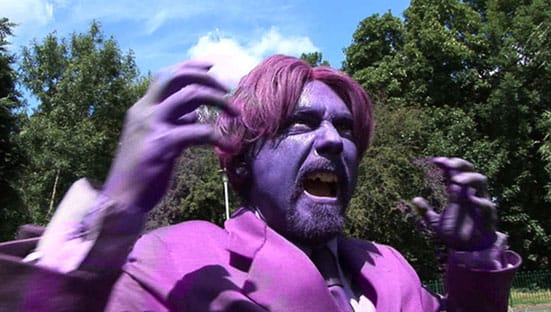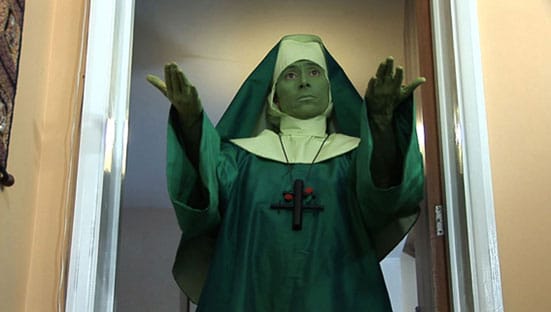14th April 2010 — 6th June 2010
'Who has the right to rule – and whose rule is right?
Who has the right to rule – and whose rule is right?
Who has the right to rule – and whose rule is right?'
Jennet Thomas's video builds to a cacophonous, nauseous climax of sound and movement, showing a purple-faced man chanting and gesticulating vague but emphatic slogans, to a soundtrack of abrasive electronic music. The piece, consisting of a half-hour video loop within a large installation, is very detailed, and operates within obtuse codes it sets up for itself, be these narrative, visual or otherwise.
The action in the video takes place in a suburban house, with insects and birdsong on the soundtrack to sunny exterior shots, bringing to mind (in a modest, suburban way) the harmonious, multi-species paradise of Jehovah's Witness pamphlets. A freakishly purple man invades the quiet home, introducing himself as a 'Son of Gaa' and talks about the needless suffering of mankind, aided by an animated video presentation projected onto a domestic slide-show screen. Mankind's problems are simplified, using coloured lumps of stuff to illustrate each one. Colour coding is a recurrent motif – flashes of colour appear at the start of the half hour loop; news photos of real tragedies are re-coloured to relate the coloured shapes in the preacher's presentation. Colour and noise intrude in the magnolia rooms – the neutrally dressed couple are cajoled by the purple man and later a bright green Nun. The video loops and switches between alternate versions of roughly the same narrative situation, the tricksy construction of the video itself belying the untrustworthy fabrications promulgated on screen by the preacher. The inattentive viewer has traps laid for them, perhaps leaving halfway through by mistake – Thomas's work demands (and rewards) concentration.
As the world of the preachers bleeds into the quiet living room in the video, so it leaks into the gallery. A large totemic object surrounded by a shiny curtain matches a smaller one that appears in the video (which then becomes a mere maquette for the version physically present in the gallery). From it emanates sound recordings similar phrases and maxims via discrete speakers installed within it; also present is a version of the purple man's 'presentation'. One day a week the installation is inhabited by performers dressed as either the Purple Preacher or Green Nun characters, I had the odd additional confusion of seeing some of the cast viewing the work – which did make sense, in a way.
The artist herself does not appear in the video, yet is oddly physically present, through the performances of her parents as the elderly couple. There is a perversity to casting your own parents in a warped story of creation, becoming mankind's progenitors, as well as the artist's – the whole of humanity shrinking to one household. This reductive way of viewing the world, which Thomas seems to be critiquing as well as joyfully employing, is emphasised, and made literal, in her use of a model village, Bekonscot. There is a weird claustrophobia invoked here (in what we could presume was the house the artist grew up in), of events too big and loud to exist in a living room. Thomas' DIY-style production, where all props are handmade and all locations 'local' (a school, the garage, the inside of a car), adds to this closeness.
This work is extremely rich in its references, from children's television to David Lynch via artists such as Nathaniel Mellors. Everything in this exhibition is seemingly both allowed to run out of control and kept on a very tight leash; the shear amount of material crammed into it is dizzying, yet totally meant; the construction of the video seems to fall apart and remake itself immediately. The work is caustic in its comment on religious evangelism, its most obvious subject matter, yet this ostensible satire is but one reading. What is being said and shown appears as a foil; merely a surface –the work decries the simplistic and overly sensical, and, in its own construction, extols the virtues of complexity and strangeness.
Richard Whitby
Matt's Gallery
42-44 Copperfield Road
London E3 4RR
http://www.mattsgallery.org/
Open
Wednesday-Sunday, 12pm-6pm

Jennet Thomas 'All Suffering SOON TO END!' 2010 (film still) Courtesy the artist and Matt's Gallery, London

Jennet Thomas 'All Suffering SOON TO END!' 2010 (film still) Courtesy the artist and Matt's Gallery, London

Jennet Thomas 'All Suffering SOON TO END!' 2010 (film still) Courtesy the artist and Matt's Gallery, London